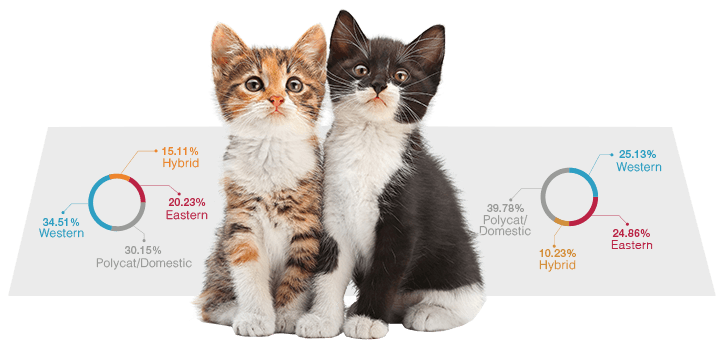Please note that this DNA test is currently not available.
How does Cat Genetic testing work?
When your cat’s cheek swab sample arrives at the laboratory, scientists will commence testing by extracting the DNA using a chemical extraction process and then proceed to read and record the feline’s unique genetic code through the use of different sequencing machines. The laboratory’s avant-garde sequencing technology allows scientists to take an extensive look at your pet’s genetic data and look at hundreds of thousands of variants to discover more information about the cat’s ancestors. All the variants are then compared to the laboratory’s large database of highly sequenced pedigreed cats so that the most genetically similar individual or groups of purebred cats can be identified.
What can be discovered through Cat DNA testing?
Based on the laboratory database, cat breeds are broken down into three different categories: Western breeds (from Europe or the Americas), Eastern breeds (from Asia) and Hybrid breeds (from wild-domestic crosses). In the test report, your mixed-breed cat will more dominantly belong to one of these three groups. Within the dominant breed group, breeds are then ranked in the order of genetic similarity, the first breed being the one your cat is most genomically similar to of all the breeds. Why don’t you take a look at the full list of cat breeds tested? As the laboratory database expands, more breeds will be added!

The report also comes with a chromosome painting, a beautiful visual representation of your cat’s genetic similarities which makes the results easier to read and understand. The chromosome map displays regions on your cat’s genome that are similar to pedigreed cat breeds from the laboratory’s database. The chromosomes will be marked with distinct colours to help you visualize where each section of the genetic code relates to the tested breeds, which will then allow you to see which breed group influenced that specific section.
The feline DNA test also identifies your cat’s similarity to different wild cats such as the cheetah, leopard and cougar! The cat DNA test report includes a wild cat index percentage which indicates how genomically similar your cat is to wild relatives. This percentage is calculated by comparing your cat’s genome to that of other cats from the laboratory’s database, big and small. The number of similarities your cat’s DNA shares with different wild cats is recorded and then ranked in similarity to the wild relatives against all other domestic cats. As more cats are tested, the wild cat index percentage value may change in later versions of the report.
What about Sample Collection and Turnaround Time?
This test requires a cheek swab sample from your cat which is relatively simple and easy to collect. Simply use the special swab provided in the Cat Genetics test kit and carefully swirl it around your cat’s mouth for a few seconds as explained in the instructions printed inside your kit.
Results for this cat DNA test are available within 8 to 10 weeks from receipt of samples at the laboratory!
Other animal DNA testing kits available
Are you worried about your cat’s health? EasyDNA provides an easy solution – the Feline PKD Testing kit offers a reliable way to detect the Polycystic Kidney Disease causing gene your cat might be carrying. The gene can be discovered even before the onset of the disease. Know more about animal testing services we offer!
Frequently Asked Questions
Does this DNA test identify the breed of my cat?
The Cat Genetics DNA test is not a breed test and does not determine the breed of your cat but rather it identifies the breeds which your cat is most similar to. The first breed listed in your report is the breed which your cat is closest to genomically. It is important to note that even mixed-breed cats of unknown origin (polycat cats) are closer to some breeds more than others.
How does this test differ from other Genetic tests?
Many genetic tests screen only for what is already known meaning that as scientists make discoveries about new genes and traits one would need to have their cat’s DNA tested again and again with each new finding. Unfortunately, there is little known about cat genetics and much more left to be discovered. Unlike similar tests, the Cat Genetics test sequences your cat’s DNA including those DNA parts which the laboratory still doesn’t know anything about. Your cat’s genetic data is then saved and as more discoveries are made about what these unknown genes are doing, we will be able to tell you more and more new things about your furry friend.

